Overview
- Features: Temple with erotic sculptures on the facade
- Opening Times: Dawn to dusk, daily
- Best Time to Visit: Late October to early March
- Duration: 30 mins to 1 hr
- Travelled By: Foot
- Cost: Western Group ticket – Indian/foreigner Rs 10/250
- Address: Rajnagar Road, Sevagram, Khajuraho, Madhya Pradesh, India
- Type: Temple
Author Reviews[display_rating_item_results rating_form_id=”2″ rating_entry_ids=”1″ show_category_filter=”false” show_options=”true” result_type=”star_rating” preserve_max_rating=”true” show_title=”false” show_count=”false” ]
Total Rating: [display_rating_result rating_form_id=”2″ show_count=”false” show_rich_snippets=true] [accordions load=”1″] [accordion title=”User Reviews” last] [display_rating_item_results rating_form_id=”5″ show_options=”true” result_type=”star_rating” preserve_max_rating=”true” show_title=”false” show_count=”true” show_rich_snippets=true] [/accordion] [accordion title=”Add Review”][display_rating_form show_email_input=”true” show_comment_textarea=”true” show_name_input=”true” rating_form_id=”5″] [/accordion] [/accordions]
Summary
Lakshmana Temple Khajuraho is arguably the biggest and best temple in Khajuraho. Before you visit this temple, read our post to find out interesting facts about Lakshmana Temple, what scenes you can expect to see as well as the architectural details of its exterior and interior. These details will enable you to look out for these particular carvings which are considered to be quite ‘saucy’.
Interesting Facts About Lakshmana Temple Khajuraho
Interesting Facts About Lakshmana Temple Khajuraho
- Belonging to the Western Group of temples, the Lakshmana Temple is one of the three largest temples in Khajuraho
- The temple was built in commemoration of military victory and temporal power of the Chandela dynasty
- Completed around 954 A.D., it is thought to be one of the earliest Chandela temples
- It took 20 years to build and was completed during the reign of Dhanga
- It is the best preserved of all Khajuraho temples
- The Lakshmana Temple is dedicated to Vishnu
- The structure is as high as it is long
- Every part of the temple is heavily decorated with a variety of sculptures that allude to the pleasures, pastimes, lifestyle, desires and conquests of the Chandela dynasty
[singlepic id=273 w=720 h=560 float=center]
Overview of Scenes Carved on Lakshmana Temple Exterior
- Horse-mounted hunters pursuing their prey
- Musicians providing lively entertainment for the court
- Couples drunk on love and liquor
- Female attendants fanning their king
- Elephants engaged in playful battle
- Soldiers on the march
- Amorous couples keeping themselves occupied in the most literal of pleasures
Exterior Scenes & Architecture of Lakshmana Temple Khajuraho
[singlepic id=276 w=720 h=560 float=center]
The Lakshmana Temple best preserves the architectural features that typify the larger temples here. The platform has friezes of hunting and battle scenes with soldiers, elephants and horses as well as scenes from daily life including the erotic. The basement again has bands of carvings – processional friezes showing animals, soldiers, acrobats, musicians, dancers, domestic scenes, festivities, ceremonies, loving couples and deities. The details differentiate between an officer (beard), general (beard and belly) and priest (beard, belly and stick). An ordinary soldier has none of these. You might spot the occasional error – a camel with legs jointed like a horse, for example. Note the beautifully carved elephants at shoulder height, each one different. On the walls are the major sculptures of gods and goddesses in two rows, with sura-sundaris or apsaras in attendance on the raised sections and loving couples discreetly placed in the recesses. All the figures are relaxed, resting their weight on one leg, thus accentuating their curves.
The bands are broken by ornate balconied windows with carved pillars and overhanging eaves. The nymphs shown attending to their toilet, bearing offerings, dancing, playing musical instruments or as sensual lovers, are executed with great skill. They are graceful and fluid (note the taut muscle or creased skin), with expressive faces and gestures. The best examples are seen in the recesses below the main tower.
[singlepic id=262 w=720 h=560 float=center]
[singlepic id=268 w=720 h=560 float=center]
The façades are covered in superb sculpture. On the south façade are a couple of minstrels, their faces expressing devotional ecstasy, a dancing Ganesh, ladies attending to their toilet, and groups of lovers. There is also a highly gymnastic orgy, including one gentleman proving that a horse can be a man’s best friend, while a shocked figure peeks out from behind her hands.
[singlepic id=267 w=720 h=560 float=center]
[singlepic id=277 w=720 h=560 float=center]
Moving to the southwest, a sura-sundari applies vermilion while another plays with a ball. In the northwest corner is a nymph after her bath in her wet clothes. The south face of the northwest shrine has a fine Ganesh panel. On the north face, returning towards the porch, there is a group of apsaras accomplished in art and music (one plays the flute, another paints, yet another writes a letter). The east face of the subsidiary shrine in the southeast corner has a master architect with his apprentices.
[singlepic id=266 w=720 h=560 float=center]
Interior Architecture of Lakshmana Temple Khajuraho
[singlepic id=263 w=720 h=560 float=center]
Leave your shoes at the entrance and enter the interior through a simple makara-torana flanked by gladiators. The circular ceiling of the porch (ardha mandapa) is a superbly carved open lotus blossom. In the hall (mandapa) is a raised platform possibly used for dancing and tantric rituals. At each corner of the platform are pillars with carved brackets with apsaras which are among the finest sculptures at Khajuraho. There are eight figures on each column, representing the eight sects of Tantra. The sanctum (garba-griha) doorway has a panel showing incarnations of Vishnu while the lintel has Lakshmi with Brahma and Siva on either side. A frieze above depicts the nine planets including Rahu, while Krishna legends and innumerable carvings of animals, birds and humans, appear on the wall. The pancha-ratha sanctum (main shrine) was built to house the three-headed image of Vishnu as Vaikuntha, which features one human head and the head of two of Vishnu’s avatars (incarnations), a lion and a boar. Around it are 10 incarnations and 14 forms of Vishnu.
[singlepic id=278 w=720 h=560 float=center]
[singlepic id=261 w=720 h=560 float=center]
Varaha, dedicated to Vishnu’s boar incarnation, and the locked Lakshmi are two small shrines facing the large Lakshmana Temple. Inside Varaha is a wonderful, 1.5 m high sandstone boar, dating from 900 A.D. and meticulously covered with carvings of several deities.
[singlepic id=275 w=720 h=560 float=center]
Tell us what you think. What do you think is Lakshmana Temple’s most attractive feature? If you’ve been here before, what was your reaction to the carvings on the temple?
We love to hear from you so please leave your comments below.


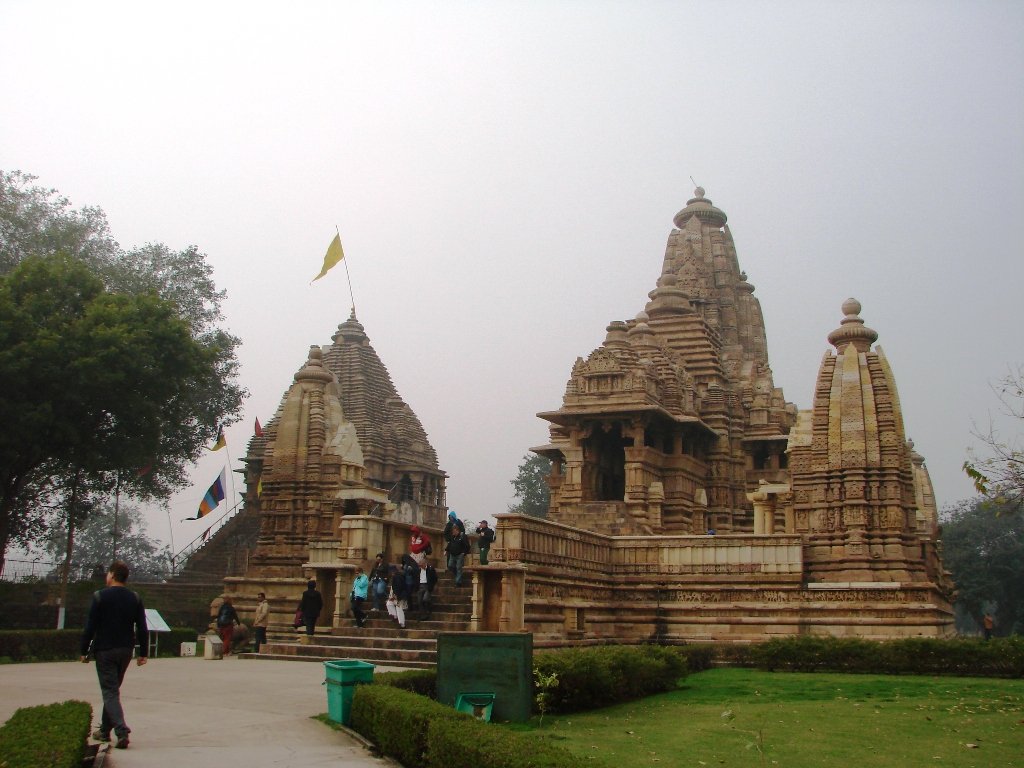
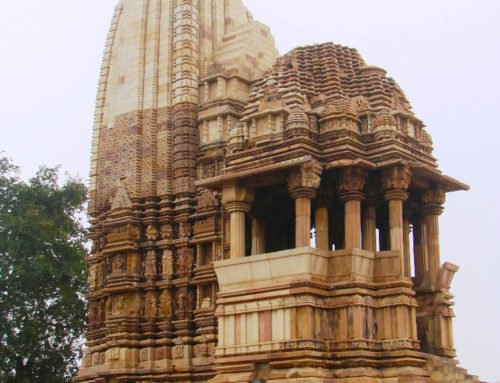
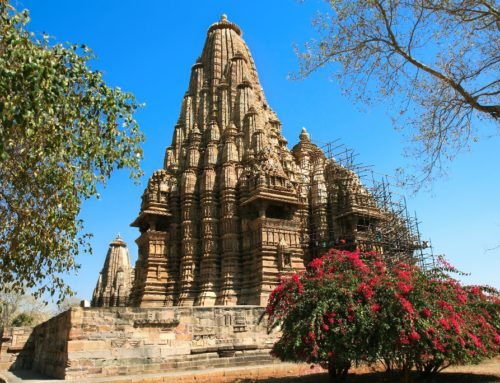

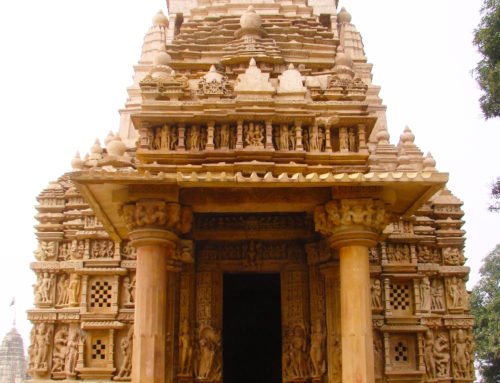
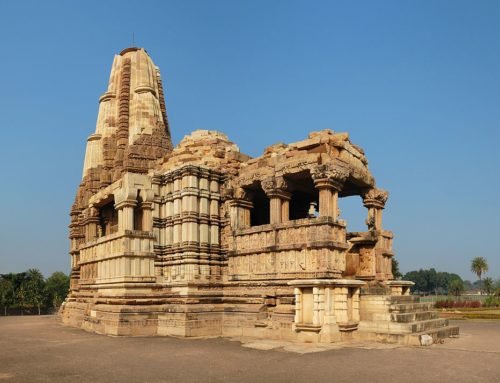
Hi, my name is Brigitte and I just want to say that your page on Lakshmana Temple is awesome. I love the pictures and the information is so interesting to read. Great work!
Thanks Brigitte. I hope you get to see this temple and the others in Khajuraho soon.